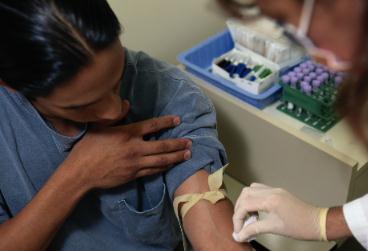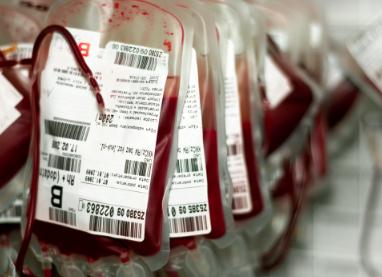
The CBS is finally ready to allow gay men to donate blood -- but only if they've abstained from sex for five years. Credit: Thinkstock

"I absolutely don't think CBS would be making this recommendation if it hadn't been for the End the Ban campaign," says Rebecca Rose. Credit: Thinkstock
Twenty-four years after banning men who have sex with men (MSM) from donating blood, the Canadian Blood Services has officially made a submission to Health Canada to change its policy. CBS staff say they are confident Health Canada will approve the policy move.
CBS has requested changing the lifetime MSM ban to a five-year deferral. That means if male donors have refrained from having sex with men for five years, they can donate blood.
CBS and its critics agree: the five-year deferral period still constitutes an outright ban against sexually active gay and bisexual men.
The Canadian Federation of Students, the group responsible for the high-profile End the Ban campaign, says they can support a five-year deferral only if Health Canada agrees to move toward a fully behaviour-based model.
“What we want to see is a comprehensive approach to reducing risk of transmission of blood-borne illnesses while at the same time not being unnecessarily discriminatory to an entire population based on a stereotype,” says CFS chair Adam Awad.
While the CBS board of directors says this is the first step in changing its policy, it has not promised any future changes.
The submission to Health Canada comes after a series of scientific advances coupled with increasingly high-profile campaigns by various groups against the arm’s-length government organization, followed by a heated PR war and, finally, a legal battle.
As pressure to change mounted, it was the lingering memory of a past tainted blood scandal that held CBS back.
Deadly new disease
Between 1910 and 1950, a deadly new illness appeared in humans living in sub-Saharan Africa. It likely arrived in the United States in the late 1960s or early 1970s, and by 1977 it was spreading rapidly across North America. Retrospectively, we know the first Canadian case was in Montreal in 1979, but initially the outbreak was invisible.
Then in Los Angeles, in 1980, pneumocystis pneumonia targeted five previously healthy gay men between the ages of 29 and 36. Two of the patients died. The following year, a rare cancer called Kaposi’s sarcoma, which occurred mainly in elderly men, attacked young gay men in New York and San Francisco.
The American Centers for Disease Control reported the fast-moving outbreak as gay-related immune deficiency, or GRID, though other organizations had different names for it.
By the summer of 1982, scientific evidence suggested the disease was blood-borne and sexually transmitted. In August of that year the CDC began referring to the disease as acquired immune deficiency syndrome (AIDS).
It wasn’t until 1984 that a retrovirus, the human immunodeficiency virus (HIV), was discovered as the cause of AIDS. According to the Public Health Agency of Canada: “[HIV] attacks the immune system, resulting in a chronic, progressive illness that leaves people vulnerable to opportunistic infections and cancers. When the body can no longer fight infection, the disease is known as AIDS.”
Brian Mombourquette, a Halifax gay man who lived through the AIDS crisis, remembers the disease was known as “the gay plague” and “the gay cancer.” Gay and bisexual men were presumed to be begging for the disease, he says; they deserved the virus, while children, heterosexuals and hemophiliacs were seen as victims.
During the early years of the AIDS outbreak, hemophiliacs — people whose bodies are unable to control blood clotting— received imported blood products from the US, where cases of HIV/AIDS were more common. It wasn’t long before blood recipients in both countries started falling ill.
In 1984, the Canadian Red Cross, responsible for blood donations at the time, said there was no evidence AIDS had been transmitted through blood products. This defensive approach would later cost them.
Tainted blood
In May 1985, the first known case of transfusion-related HIV was reported. But by then the virus had already infected hundreds of Canadians through the blood supply. Tainted blood products would eventually infect as many as 2,000 Canadians.
The Canadian Red Cross was slow to implement blood testing for HIV/AIDS and hepatitis C. Worse still, when a blood-clotting product for hemophiliacs known as Factor VIII was suspected of carrying HIV, the Canadian Red Cross did not stop distributing it.
Instead, in 1986 the Canadian Red Cross printed pamphlets encouraging donors at high risk of contracting HIV to self-exclude, including the group identified as the highest risk: “Any male who has had sex with another male since 1977.”
In 1988, the Canadian Red Cross introduced its first official MSM policy. Donors were asked if they used drugs intravenously, if they lived in an area where AIDS was common, if they received treatment with blood products, if they were a man who had sex with men, or if they had had sex with anyone who would say yes to any of the above.
By this time, transfusion-infected recipients had called repeatedly on the government for compensation. The federal government announced a $150-million package in 1989 for patients who agreed not to sue them. Provincial governments later announced $30,000 a year in compensation.
In 1993, a House of Commons sub-committee called for a public inquiry into the blood scandal. In the resulting report, Justice Krever called the Canadian Red Cross an “ineffective decision maker that recoiled from its responsibility to make timely decisions.” His report also laid blame with Health Canada, provincial governments, physicians, hospitals and blood product manufacturers.
As a result of his recommendation that the blood service exist separately from the government, the Canadian Blood Service was established as an arm’s-length independent organization — unbound by the Canadian Charter of Rights and Freedoms.
The CBS embraced the Krever report, including the principle that “safety of the blood supply system is paramount,” and promised the blood supply would never be compromised again.
Public pressure
In the years to follow, the CBS received letters demanding it drop the lifetime deferral and experienced increasingly high-profile demonstrations against the policy by the Canadian AIDS Society and Egale.
Then, in 2002, Kyle Freeman sent CBS an email admitting he had lied when asked the MSM question and gave blood regularly as a sexually active gay man. Freeman did not have HIV or AIDS, though one of his blood donations tested positive for syphilis. In the email he condemned the policy, calling it discriminatory.
Claiming their screening process was “purposefully compromised,” the blood service went to court to find out Freeman’s identity from his internet service provider.
When they discovered his identity, the CBS sued Freeman in 2002 for negligent misrepresentation. Freeman filed a counter-suit against the CBS and Health Canada, saying he experienced “humiliation, degradation and marginalization” from the MSM screening question. He claimed the lifetime ban on blood from gay men violated his Charter right to not be discriminated against based on his sexuality.
While Freeman waited for a court date, organizations sympathetic to his cause launched their highest profile efforts: the End the Ban campaign. Calling for behaviour-based screening, in 2006 Egale and the CFS targeted campuses to make students aware of the discriminatory policy. Because students are a major donor group, this strategy got the CBS’s attention and the two sides began a dialogue about the policy.
In 2010, Justice Catherine Aitkin weighed in favour of CBS, ruling Freeman was negligent when he lied on the screening question.
Importantly, though, the judge wrote in her ruling that the current lifetime refusal had no scientific basis. She recommended a 10-year deferral instead.
The decision was bittersweet for anti-ban groups. When the ruling came down, Egale, the CAS and the CFS announced they would resign from the CBS’s queer consultation group. For years the groups had the ear of the CBS in relation to its MSM policy, but the blood services’ aggressive pursuance of Freeman in court soured their relationship.
“We didn’t really feel like they were consulting in good faith,” CFS Maritime organizer Rebecca Rose says. “Things have changed a bit since then.”
Today, end-the-ban advocates are on better terms with the CBS due to the blood service’s willingness to move to a five-year deferral — the shortest length of time the CBS board allowed. “They went with the sort of most progressive option they were allowed to take,” Awad says.
But the CFS remains skeptical.
When asked if the CBS would have changed its policy if not for pressure from the anti-ban campaigns, Rose says, “No, I absolutely don’t think CBS would be making this recommendation if it hadn’t been for the End the Ban campaign and the work students have done in conjunction with the CAS and Egale. No.”
“I might be really cynical, but I don’t think so,” Awad says when asked the same question.
As for the CBS, its representatives agree the campaigns coupled with the Freeman case influenced the change.
“It certainly got our attention — no question,” says Dana Divine, CBS’s vice-president of medical and scientific research. “It’s important to us that people are not walking away from our clinics for reasons like that.”
The CFS campaign made the MSM policy change a priority, she says.
CBS periodically reviews its policies, Divine explains. After a policy review in 2006, the deferral remained unchanged. Once the Freeman ruling came down, however, the CBS reconsidered the science once again.
After stakeholder consultations in spring 2012, she says, the CBS finalized the five-year period.

 Why you can trust Xtra
Why you can trust Xtra


